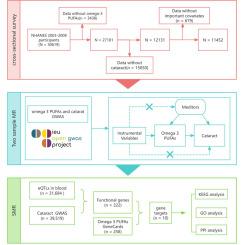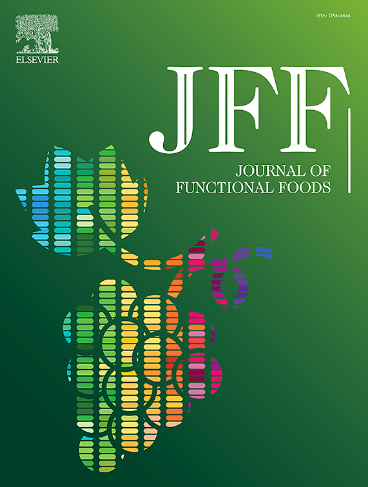omega-3多不饱和脂肪酸与白内障之间的关系:来自横断面调查和孟德尔随机分析的结果
IF 4
2区 农林科学
Q2 FOOD SCIENCE & TECHNOLOGY
引用次数: 0
摘要
本研究通过观察和遗传相结合的方法探讨了omega-3多不饱和脂肪酸(PUFAs)与白内障风险之间的关系。全国健康与营养调查(2003-2008)的横断面分析显示,较高的omega-3 PUFA摄入量与白内障风险呈负相关(完全校正OR = 0.74, 95% CI: 0.57-0.97, P = 0.041)。使用大规模遗传数据的孟德尔随机化分析证实了这种保护作用(方差加权后的OR = 0.92, 95% CI: 0.86-0.99, P = 0.044),在敏感性分析中结果一致。基于总结数据的孟德尔随机化进一步确定了10个通过脂质生物合成、氧化应激和炎症相关途径将omega-3 PUFA代谢与白内障联系起来的基因。这些发现提供了一致的证据,证明摄入omega-3 PUFA可以降低白内障的风险,并强调了这种关联的可能的分子机制。本文章由计算机程序翻译,如有差异,请以英文原文为准。

Association between omega-3 polyunsaturated fatty acids and cataracts: results from a cross-sectional survey and mendelian randomization analysis
This study investigated the association between omega-3 polyunsaturated fatty acids (PUFAs) and cataract risk by combining observational and genetic approaches. A cross-sectional analysis of the National Health and Nutrition Examination Survey (2003–2008) showed that higher omega-3 PUFA intake was inversely associated with cataract risk (fully adjusted OR = 0.74, 95 % CI: 0.57–0.97, P = 0.041). This protective effect was corroborated by Mendelian randomization analyses using large-scale genetic data (inverse variance weighted OR = 0.92, 95 % CI: 0.86–0.99, P = 0.044), with consistent results across sensitivity analyses. Summary-data-based Mendelian randomization further identified ten genes linking omega-3 PUFA metabolism to cataract through pathways related to lipid biosynthesis, oxidative stress, and inflammation. These findings provide convergent evidence that omega-3 PUFA intake may reduce cataract risk and highlight putative molecular mechanisms underlying this association.
求助全文
通过发布文献求助,成功后即可免费获取论文全文。
去求助
来源期刊

Journal of Functional Foods
FOOD SCIENCE & TECHNOLOGY-
CiteScore
9.60
自引率
1.80%
发文量
428
审稿时长
76 days
期刊介绍:
Journal of Functional Foods continues with the same aims and scope, editorial team, submission system and rigorous peer review. We give authors the possibility to publish their top-quality papers in a well-established leading journal in the food and nutrition fields. The Journal will keep its rigorous criteria to screen high impact research addressing relevant scientific topics and performed by sound methodologies.
The Journal of Functional Foods aims to bring together the results of fundamental and applied research into healthy foods and biologically active food ingredients.
The Journal is centered in the specific area at the boundaries among food technology, nutrition and health welcoming papers having a good interdisciplinary approach. The Journal will cover the fields of plant bioactives; dietary fibre, probiotics; functional lipids; bioactive peptides; vitamins, minerals and botanicals and other dietary supplements. Nutritional and technological aspects related to the development of functional foods and beverages are of core interest to the journal. Experimental works dealing with food digestion, bioavailability of food bioactives and on the mechanisms by which foods and their components are able to modulate physiological parameters connected with disease prevention are of particular interest as well as those dealing with personalized nutrition and nutritional needs in pathological subjects.
 求助内容:
求助内容: 应助结果提醒方式:
应助结果提醒方式:


